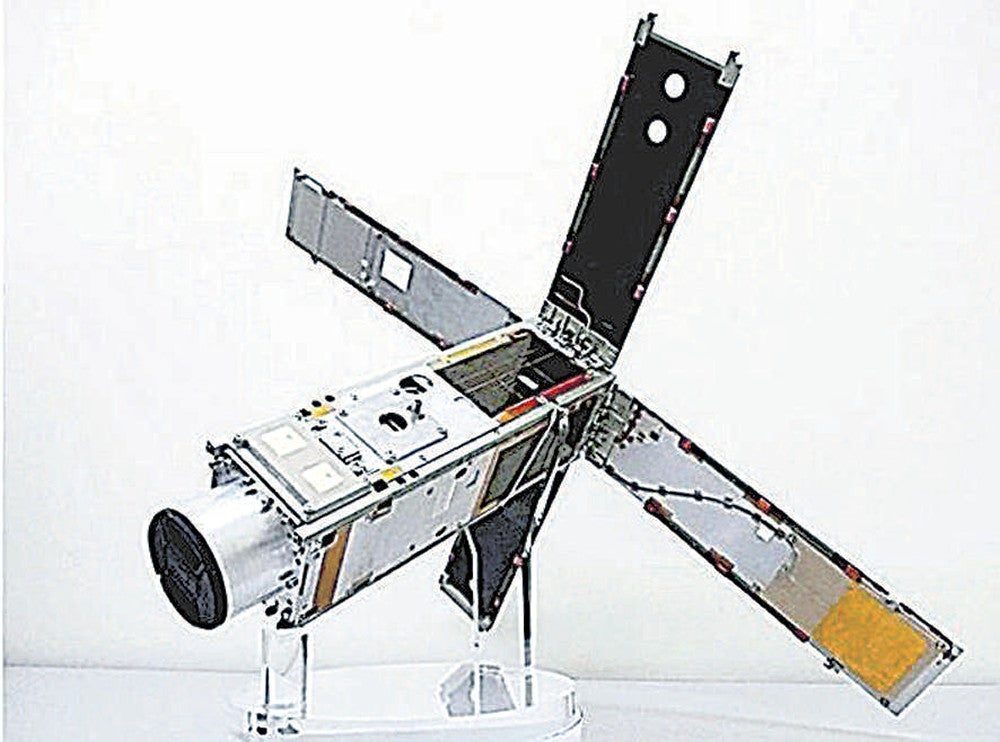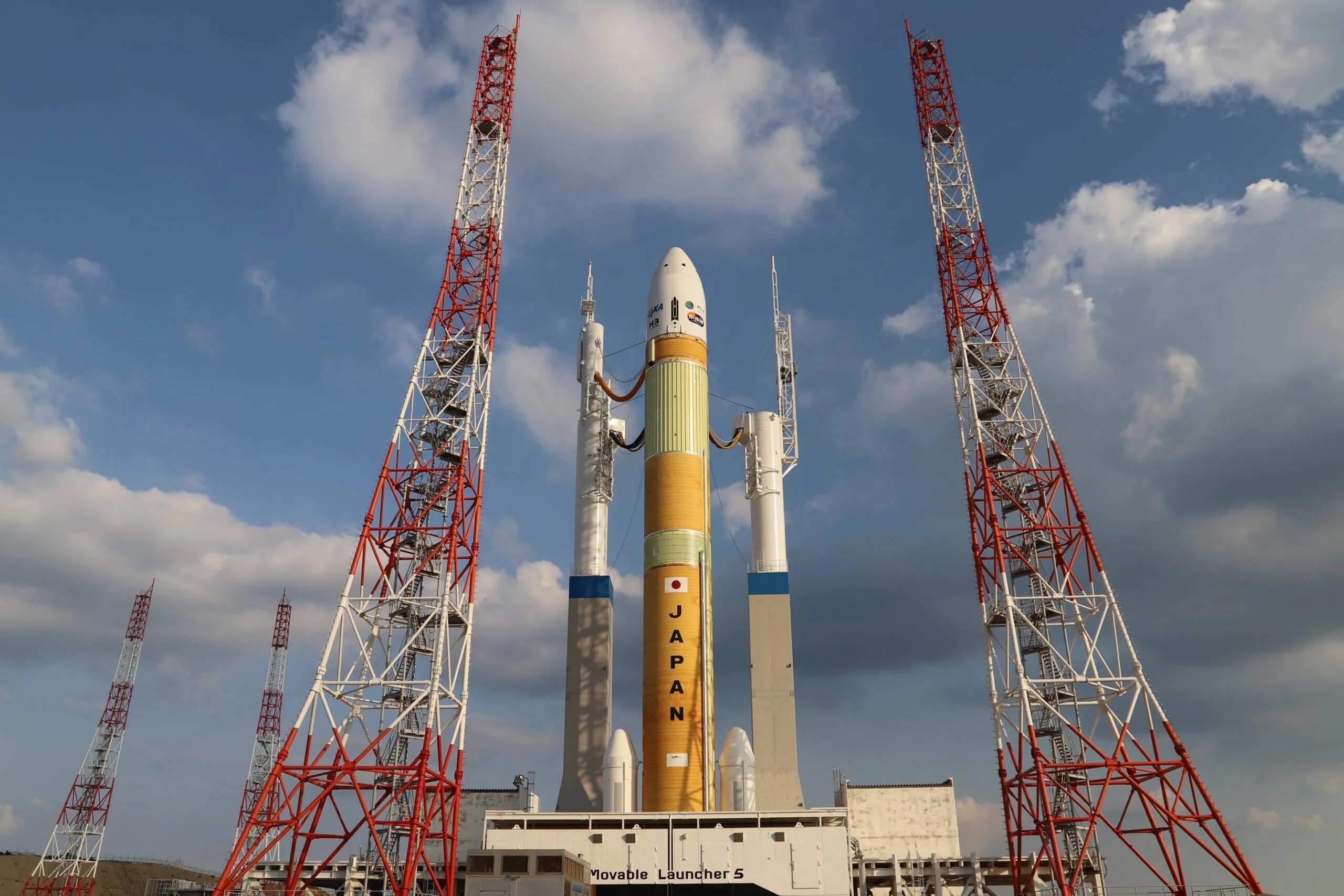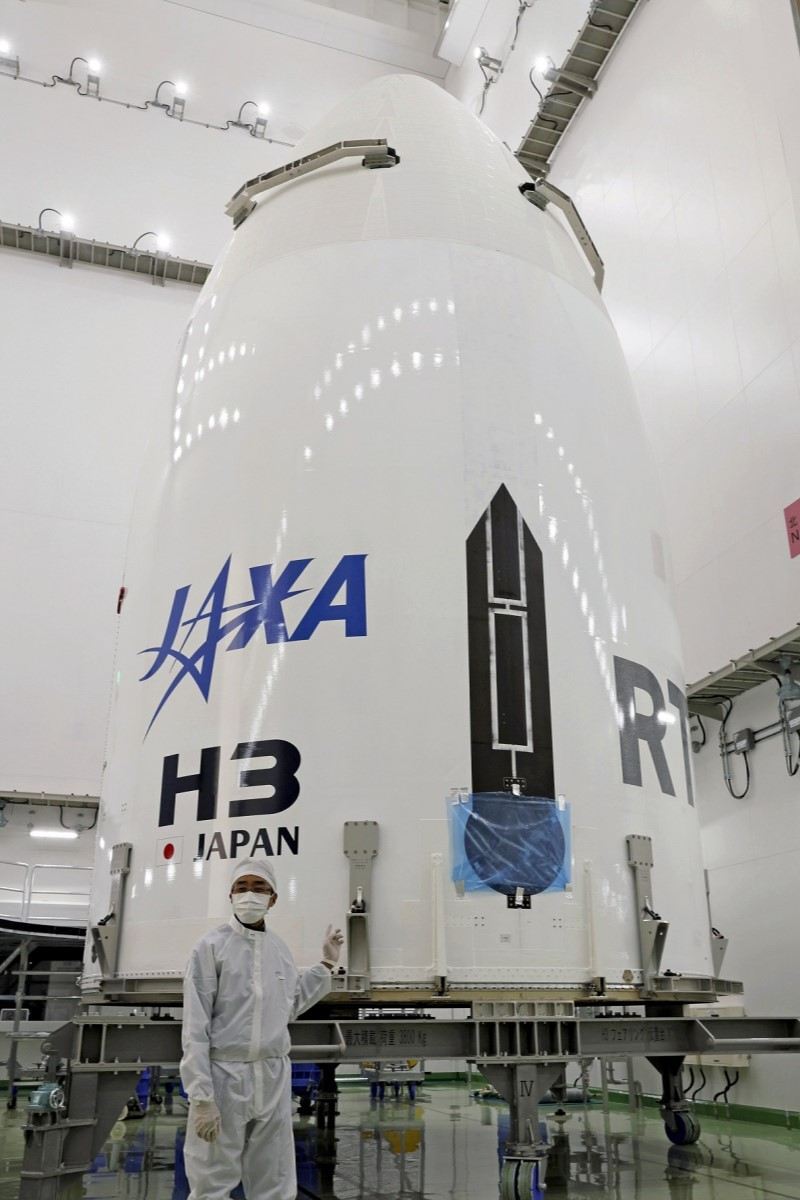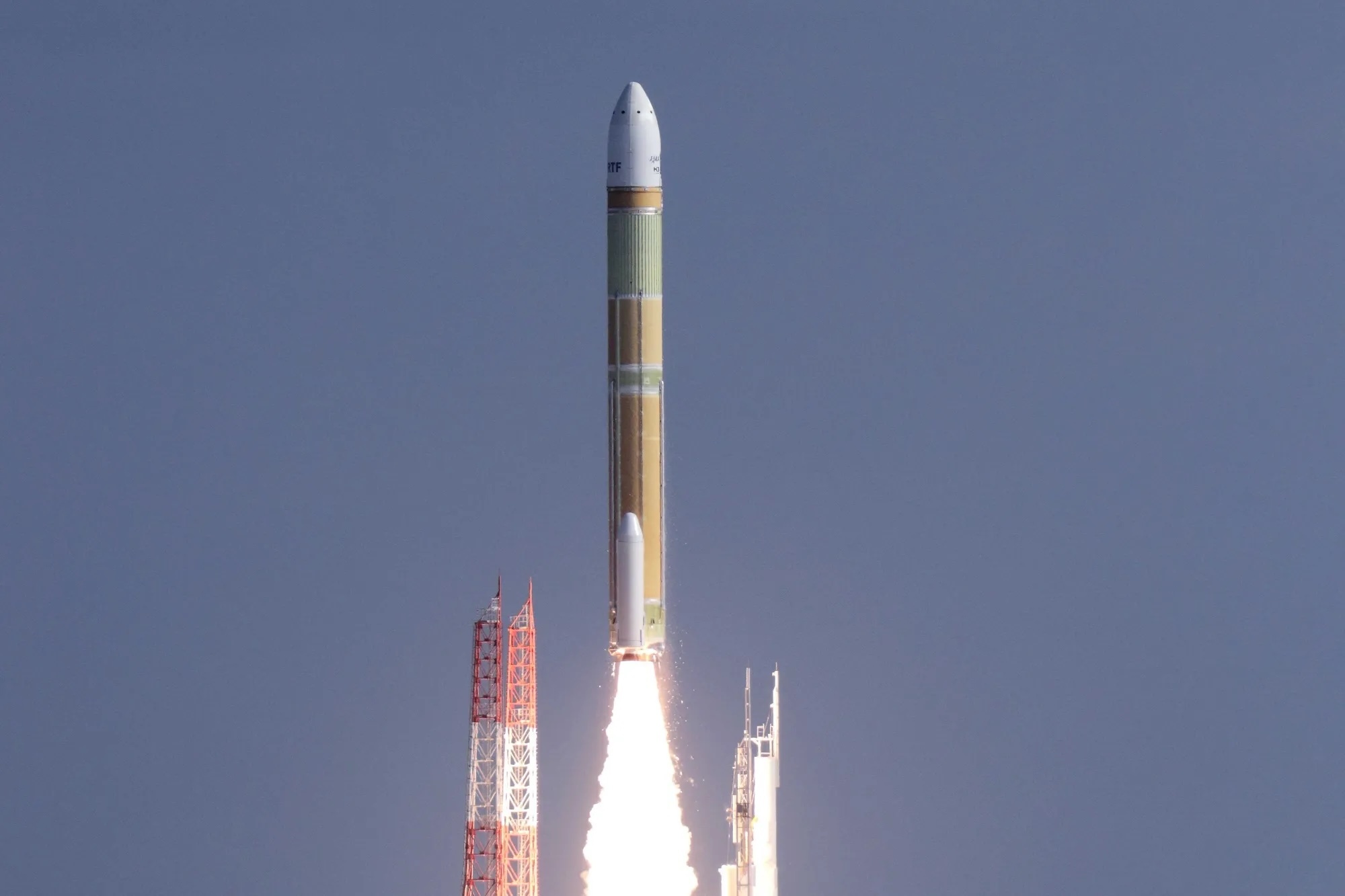28.06.2023

Courtesy of the Education, Culture, Sports, Science and Technology Ministry
A model of the TIRSAT microsatellite
The Japan Aerospace Exploration Agency (JAXA) plans to send two microsatellites into orbit with the second launch of its H3 rocket following the failure of the first H3 rocket shortly after its launch in March.
JAXA presented the plan at a meeting of experts organized by the Education, Culture, Sports, Science and Technology Ministry on Tuesday.
A dummy satellite will be carried as the main payload for the second launch of the H3 rocket, but the two microsatellites will also be aboard.
One of the satellites, dubbed CE-SAT-1E, is equipped with a sensor capable of taking pictures in visible light like a regular camera. The microsatellite weighs about 50 kilograms and was developed by Canon Electronics Inc.
This satellite is expected to partially fulfill the function of emergency observation following natural disasters that was initially planned to be performed by the Daichi-3 land observation satellite, which was lost when the first H3 rocket failed.
The other satellite, dubbed TIRSAT, was developed by Japan Space Systems and other institutes. It will be equipped with a sensor to detect infrared rays and will be able to observe the temperature of the Earth’s surface and seawater.
The schedule of the second launch will be determined based on the progress of the investigation into the cause of the failure of the first launch.
The first H3 rocket was destroyed on command because its second-stage engine failed to ignite. The rocket fell into the ocean along with its payload, the Daichi-3 satellite.
Quelle: The Japan News
----
Update: 30.12.2023
.
Second H3 launch planned for February

JAXA's new H3 rocket on the pad in March 2023. Credit: JAXA
SANTA FE, N.M. — The Japanese space agency JAXA has set a mid-February date for the return to flight of the H3 rocket, nearly a year after the vehicle’s first launch failed.
JAXA announced Dec. 27 that the second launch of the H3 was scheduled for no earlier than Feb. 14 (Feb. 15 Japanese time) from the Tanegashima Space Center. The launch period for the mission, designated H3 Test Flight No. 2 or H3TF2, extends through the end of March.
The launch will be the first for the H3 since its unsuccessful inaugural flight March 7. On that launch the first stage appeared to perform as expected but the engine in the second stage failed to ignite, triggering the vehicle’s flight termination system.
Neither JAXA nor Mitsubishi Heavy Industries (MHI), the prime contractor for the H3, have disclosed many details about the cause of the failure. Because the second stage engine is similar to the one used on the existing H-2A, a launch of that vehicle carrying the XRISM X-ray astronomy satellite and SLIM lunar lander was delayed from May to September.
Iwao Igarashi, vice president and general manager of MHI, said at the World Satellite Business Week conference in September that the investigation into the H3 failure was completed in August but did not discuss what that investigation revealed.
“We defined the corrective actions and some of them applied to the H-2A launch vehicle,” he said at the conference, which took place less than a week after that vehicle launched XRISM and SLIM. “The next step is we are working hard to prepare for the return to flight” of the H3, which at the time he said was planned for late 2023.
A change for the second H3 launch will be the payload. For the first launch, JAXA flew the ALOS-3 Earth observation satellite, a spacecraft that cost about $200 million. The agency faced sharp criticism after the failure for placing a valuable spacecraft on the rocket’s first flight.
The upcoming H3 launch will instead carry a test payload, called the Vehicle Evaluation Payload-4. The mission will also carry two smallsat secondary payloads. One, CE-SAT-1E, is an Earth imaging spacecraft developed by Canon Electronics. The other, TIRSAT, is a cubesat built by Japan Space Systems with an infrared Earth observation instrument.
Quelle: SN
----
Update: 8.02.2024
.
JAXA Unveils Portion of 2nd H3 Rocket Set to Launch Feb. 15; Success of Launch Dependent on Functionality of New Equipment

The payload fairing, which will be used during the second H3 launch, is shown to the press at Tanegashima Space Center in Kagoshima Prefecture on Tuesday.
The Japan Aerospace Exploration Agency (JAXA) has unveiled a part of the fuselage of its second H3 mainstay rocket and a satellite it will carry ahead of its launch on Feb. 15 from Tanegashima Space Center in Kagoshima Prefecture.
JAXA showed the press the satellite’s payload fairing, which is a protective cover that will be attached to the tip of the rocket to protect the satellite during launch, on Jan 23. The success of the launch will depend on whether the fairing, measuring 10.4 meters high and 5.2 meters in diameter, functions properly.
The first H3 rocket’s launch ended in failure in March last year. The rocket was deliberately destroyed in-flight with the government’s land observation satellite Daichi-3 aboard. The second H3 will carry a mock satellite, which weighs the same as the Daichi-3, in its payload fairing.
JAXA also unveiled two other satellites.
The CE-SAT-1E weighs about 70 kilograms and was developed by Canon Electronics Inc. The microsatellite combines a digital camera and telescope to take high-resolution images of objects on the ground and in space.
The TIRSAT weighs about 5 kilograms and was developed by Japan Space Systems and other entities. The TIRSAT nanosatellite is equipped with an infrared sensor to detect heat sources on the ground to determine the operation conditions of factories.
“We want to be precise when performing individual tasks to ensure a successful launch,” said Masashi Okada, JAXA project manager of the H3 rocket.
Quelle: The Japan News
----
Update: 13.02.2024
.
Japan's space program seeks reboot with Wednesday launch
Second test flight for failed H3 booster after a run of bad luck
Japan will on Wednesday try to reboot its space program with a second test flight for its H3 booster.
The H3 has been a decade in the making and can launch under its own power, or with the assistance of two or four external boosters. The craft's payload capabilities don't vastly exceed the workhorse H-IIA that Japan has successfully launched almost 50 times, but it is cheaper to operate. Japan's space exploration agency (JAXA) hopes the H3 will therefore allow it to launch more of its own payloads and win business. The launcher will also help JAXA's contributions to the International Space Station.
Sadly, March 2023's debut H3 launch did not go well. At the time, JAXA thought the command to ignite its second stage was not received. After observing telemetry suggesting the rocket had worryingly slowed its ascent, JAXA sent an instruction to self-destruct. That message was received and executed, sending the H3 and the land observation satellite it carried to their doom.
A subsequent investigation found the ignition command was probably received, but a minor short circuit in equipment used to ignite the second stage was the reason for the failure. The investigation found that short could be avoided with extra insulation and closer inspection of the rocket during assembly.
That work has presumably been undertaken – and checked many times over – ahead of Wednesday's second test.
This time around the H3 will carry three payloads.
One is romantically named the "Vehicle Evaluation Payload-4" and weighs about as much as the kind of payloads future H3 launches are hoped to hoist. It includes acoustic and temperature sensors, plus accelerometers, to help JAXA understand the launcher's performance.
An Earth imaging satellite named CE-SAT-1E and built by Canon is also aboard, along with an Earth observation CubeSat called TIRSAT.
Success for the H3 is devoutly to be wished, as JAXA has had a rotten run of luck recently. Its moon lander landed upside down and a recent launch of the Epsilon light lifter also failed.
India's space agency, ISRO, is also in action this week with a planned Saturday launch for the INSAT-3DS meteorological satellite atop a Geosynchronous Satellite Launch Vehicle.
Quelle: The Register
----
Update: 17.02.2024
.
Japan's new flagship H3 rocket reaches orbit in a key test after failed debut last year
Japan’s flagship H3 rocket has reached orbit and released two small observation satellites in a key second test following a failed debut launch last year, buoying hope for the country in the global space race
TOKYO -- Japan's flagship H3 rocket reached orbit and released two small observation satellites in a key second test following a failed debut launch last year, buoying hope for the country in the global space race.
The H3 rocket blasted off from the Tanegashima Space Center on time Saturday morning, two days after its originally scheduled liftoff was delayed by bad weather.
The rocket successfully reached orbit at an altitude of about 670 kilometers (about 420 miles) and released two satellites, the Japan Aerospace Exploration Agency, or JAXA, said.
“We feel so relieved to be able to announce the good results," JAXA President Hiroshi Yamakawa told a news conference.
The H3's main missions are to secure independent access to space and be competitive as international demand for satellite launches grows. “We made a big first step today toward achieving that goal," Yamakawa said.
The launch is a boost for Japan’s space program following a recent streak of successes, including a historic precision touchdown on the moon of an unmanned spacecraft last month.
The liftoff was closely watched as a test for Japan’s space development after H3, in its debut flight last March, failed to ignite the second-stage engine. JAXA and its main contractor Mitsubishi Heavy Industries have been developing H3 as a successor to its current mainstay, H-2A, which is set to retire after two more flights.
As the rocket soared and released its first payload successfully, project members at the JAXA command center cheered and hugged each other in livestreaming footage. NHK television showed some staff at a press center crying with relief and joy.
JAXA H3 project manager Masashi Okada called the result “perfect,” saying H3 cleared all missions set for Saturday's flight. “After a long wait, the newborn H3 finally had its first cry.”
“I now feel a heavy load taken off my shoulders. But now is the real start for H3, and we will work to steadily improve it," Okada said.
The H3 No. 2 rocket was decorated with thousands of stickers carrying messages sent from well-wishers around the country.
Two microsatellites — observation satellite CE-SAT-IE, developed by Canon Electronics, and TIRSAT, which was co-developed by a number of companies and universities — were piggybacked on the H3 Saturday. Their makers said they were willing to take the chance as they see a growing market in the satellite business.
The 57-meter (187-feet) -long H3 is designed to carry larger payloads than H-2A at much lower costs of about 50 billion yen ($330 million), to be globally competitive.
Masayuki Eguchi, head of defense and space segment at Mitsubishi Heavy, said his company hopes to achieve better price competitiveness after about a dozen more launches.
“I'm delighted to see this incredible accomplishment in the space sector right after the success of the SLIM moon landing,” Prime Minister Fumio Kishida said on X, formerly Twitter. “I expect the Japanese mainstay rocket will steadily make achievement.”
Last month, a H-2A rocket successfully placed a spy satellite into its planned orbit, and days later JAXA’s unmanned spacecraft SLIM made the world’s first “pinpoint” moon landing then captured lunar data.
Quelle: abcNews
+++
H3 reaches orbit on second launch

A Japanese H3 rocket lifts off Feb. 16 on a test flight nearly a year after its inaugural launch failed. Credit: JAXA
WASHINGTON — Japan’s H3 rocket successfully reached orbit on its second launch Feb. 16, nearly a year after its inaugural launch failed.
The H3 rocket lifted off from the Tanegashima Space Center at 7:22 p.m. Eastern after a two-day delay caused by weather. There were no issues reported during the countdown, with liftoff occurring at the beginning of a window lasting more than two and a half hours.
A key point in the launch was the separation of the upper stage and ignition of its LE-5B-3 engine. On the vehicle’s inaugural launch in March 2023, that engine failed to ignite, forcing controllers to issue a destruct command to destroy the stage and its payload, the ALOS-3 Earth observation satellite.
On this launch, designated H3 Test Flight 2 (H3TF2) by the Japanese space agency JAXA, the engine did ignite. The stage reached a preliminary orbit of about 674 kilometers 16 and a half minutes after liftoff, and moments later deployed one of its payloads, the CE-SAT-1E imaging satellite built by Canon Electronics.
It was scheduled to be followed about nine minutes later by the other secondary payload, a cubesat called TIRSAT. JAXA said in a later statement that the separation signal for tIRSAT was sent, but did not explicitly state that the cubesat had deployed.
A second burn of the upper stage took place one hour and 47 minutes after liftoff, lasting 26 seconds. After that, the upper stage deployed its primary payload, a mass simulator called Vehicle Evaluation Payload (VEP) 4. VEP-4 is a metallic column with the same mass and center of gravity as ALOS-3. JAXA flew the inert payload after criticism about flying ALOS-3, a $200 million satellite, on the rocket’s first launch.
That second burn was designed to demonstrate the ability to perform a controlled reentry of both the upper stage and VEP-4, said Yasuo Ishii, JAXA vice president, during a session of the Space Debris Conference organized by the Saudi Space Agency Feb. 11.
JAXA and the vehicle’s prime contractor, Mitsubishi Heavy Industries, spent months investigating the inaugural launch failure. Engineers concluded that while the rocket received the signal to ignite the engine, an electrical failure prevented the ignition system from starting up.
While the investigation did not identify a single root cause, it did find three scenarios that most likely explained what happened: a short-circuit in wiring in the ignition system, a failed transistor in the ignition system and a failure in one computer in the stage’s control system that sent electrical current to a redundant computer that caused it to fail. JAXA made changes to prevent any of those scenarios from reoccurring.
The potential problems with the ignition system also affected the older H-2A rocket, which uses a version of the same upper-stage engine. That grounded the H-2A for half a year, with the rocket returning to flight in September.
The H3 is key to Japan’s future space plans. The rocket will succeed the H-2A and launch civil and military missions, including the new HTV-X spacecraft that will transport cargo to the International Space Station. The H3 is also designed to operate at far lower costs than the H-2A, making the vehicle more competitive in the commercial launch market.
Quelle: SN
